Checkered Films of Multiaxis Oriented Nanocelluloses by Liquid-Phase Three-Dimensional Patterning
Abstract
1. Introduction
2. Materials and Methods
3. Results
3.1. Concept of Liquid-Phase 3D Patterning
3.2. Cooperation between Discharging and Patterning
3.3. Patterning Results
3.4. Multiaxis Oriented Nanocellulose Film
4. Discussion
5. Conclusions
Supplementary Materials
Author Contributions
Funding
Acknowledgments
Conflicts of Interest
References
- Dawson, C.; Vincent, J.F.V. How pine cones open. Nature 1997, 390, 668. [Google Scholar] [CrossRef]
- Shopsowitz, K.E.; Kelly, J.A.; Hamad, W.Y.; MacLachlan, M.J. Biopolymer templated glass with a twist: Controlling the chirality, porosity, and photonic properties of silica with cellulose nanocrystals. Adv. Funct. Mater. 2014, 24, 32–338. [Google Scholar] [CrossRef]
- Parker, R.M.; Guidetti, G.; Williams, C.A.; Zhao, T.; Narkevicius, A.; Vignolini, S.; Frka-Petesic, B. The self-assembly of cellulose nanocrystals: Hierarchical design of visual appearance. Adv. Mater. 2018, 30, 1704477. [Google Scholar] [CrossRef] [PubMed]
- Mohammadi, P.; Toivonen, M.S.; Ikkala, O.; Wagermaier, W.; Linder, M.B. Aligning cellulose nanofibril dispersions for tougher fibers. Sci. Rep. 2017, 7, 11860. [Google Scholar] [CrossRef] [PubMed]
- Iwamoto, S.; Isogai, A.; Iwata, T. Structure and mechanical properties of wet-spun fibers made from natural cellulose nanofibers. Biomacromolecules 2011, 12, 831–836. [Google Scholar] [CrossRef] [PubMed]
- Walther, A.; Timonen, J.V.; Diez, I.; Laukkanen, A.; Ikkala, O. Multifunctional high-performance biofibers based on wet-extrusion of renewable native cellulose nanofibrils. Adv. Mater. 2011, 23, 2924–2928. [Google Scholar] [CrossRef]
- Lundahl, M.J.; Cunha, A.G.; Rojo, E.; Papageorgiou, A.C.; Rautkari, L.; Arboleda, J.C.; Rojas, O.J. Strength and water interactions of cellulose i filaments wet-spun from cellulose nanofibril hydrogels. Sci. Rep. 2016, 6, 30695. [Google Scholar] [CrossRef]
- Sehaqui, H.; Ezekiel Mushi, N.; Morimune, S.; Salajkova, M.; Nishino, T.; Berglund, L.A. Cellulose nanofiber orientation in nanopaper and nanocomposites by cold drawing. ACS Appl. Mater. Interfaces 2012, 4, 1043–1049. [Google Scholar] [CrossRef]
- Diaz, J.A.; Wu, X.; Martini, A.; Youngblood, J.P.; Moon, R.J. Thermal expansion of self-organized and shear-oriented cellulose nanocrystal films. Biomacromolecules 2013, 14, 2900–2908. [Google Scholar] [CrossRef]
- Uetani, K.; Okada, T.; Oyama, H.T. In-plane anisotropic thermally conductive nanopapers by drawing bacterial cellulose hydrogels. ACS Macro Lett. 2017, 6, 345–349. [Google Scholar] [CrossRef]
- Uetani, K.; Koga, H.; Nogi, M. Estimation of the intrinsic birefringence of cellulose using bacterial cellulose nanofiber films. ACS Macro Lett. 2019, 8, 250–254. [Google Scholar] [CrossRef]
- Nishiyama, Y.; Kuga, S.; Wada, M.; Okano, T. Cellulose microcrystal film of high uniaxial orientation. Macromolecules 1997, 30, 6395–6397. [Google Scholar]
- Tatsumi, M.; Teramoto, Y.; Nishio, Y. Different orientation patterns of cellulose nanocrystal films prepared from aqueous suspensions by shearing under evaporation. Cellulose 2015, 22, 2983–2992. [Google Scholar] [CrossRef]
- Song, G.; Kimura, F.; Kimura, T.; Piao, G. Orientational distribution of cellulose nanocrystals in a cellulose whisker as studied by diamagnetic anisotropy. Macromolecules 2013, 46, 8957–8963. [Google Scholar] [CrossRef]
- Kondo, T.; Nojiri, M.; Hishikawa, Y.; Togawa, E.; Romanovicz, D.; Brown, R.M., Jr. Biodirected epitaxial nanodeposition of polymers on oriented macromolecular templates. Proc. Natl. Acad. Sci. USA 2002, 99, 14008–14013. [Google Scholar] [CrossRef] [PubMed]
- Uetani, K.; Yano, H. Semiquantitative structural analysis of highly anisotropic cellulose nanocolloids. ACS Macro Lett. 2012, 1, 651–655. [Google Scholar] [CrossRef]
- Skogberg, A.; Maki, A.J.; Mettanen, M.; Lahtinen, P.; Kallio, P. Cellulose nanofiber alignment using evaporation-induced droplet-casting, and cell alignment on aligned nanocellulose surfaces. Biomacromolecules 2017, 18, 3936–3953. [Google Scholar] [CrossRef]
- Toivonen, M.S.; Kurki-Suonio, S.; Wagermaier, W.; Hynninen, V.; Hietala, S.; Ikkala, O. Interfacial polyelectrolyte complex spinning of cellulose nanofibrils for advanced bicomponent fibers. Biomacromolecules 2017, 18, 1293–1301. [Google Scholar] [CrossRef]
- Smith, K.B.; Tisserant, J.-N.; Assenza, S.; Arcari, M.; Nyström, G.; Mezzenga, R. Confinement-induced ordering and self-folding of cellulose nanofibrils. Sci. Adv. 2018, 6, 1801540. [Google Scholar] [CrossRef]
- Hakansson, K.M.; Fall, A.B.; Lundell, F.; Yu, S.; Krywka, C.; Roth, S.V.; Santoro, G.; Kvick, M.; Prahl Wittberg, L.; Wagberg, L.; et al. Hydrodynamic alignment and assembly of nanofibrils resulting in strong cellulose filaments. Nat. Commun. 2014, 5, 4018. [Google Scholar] [CrossRef]
- Siqueira, G.; Kokkinis, D.; Libanori, R.; Hausmann, M.K.; Gladman, A.S.; Neels, A.; Tingaut, P.; Zimmermann, T.; Lewis, J.A.; Studart, A.R. Cellulose nanocrystal inks for 3D printing of textured cellular architectures. Adv. Funct. Mater. 2017, 27, 1604619. [Google Scholar] [CrossRef]
- Markstedt, K.; Mantas, A.; Tournier, I.; Ávila, H.M.; Hagg, D.; Gatenholm, P. 3D bioprinting human chondrocytes with nanocellulose−alginate bioink for cartilage tissue engineering applications. Biomacromolecules 2015, 16, 1489–1496. [Google Scholar] [CrossRef] [PubMed]
- Capadona, J.R.; Van den Berg, O.; Capadona, L.A.; Schroeter, M.; Rowan, S.J.; Tyler, D.J.; Weder, C. A versatile approach for the processing of polymer nanocomposites with self-assembled nanofibre templates. Nat. Nanotechnol. 2007, 2, 765–769. [Google Scholar] [CrossRef] [PubMed]
- Uetani, K.; Okada, T.; Oyama, H.T. Crystallite Size effect on thermal conductive properties of nonwoven nanocellulose sheets. Biomacromolecules 2015, 16, 2220–2227. [Google Scholar] [CrossRef]
- Uetani, K.; Yano, H. Nanofibrillation of wood pulp using a high-speed blender. Biomacromolecules 2011, 12, 348–353. [Google Scholar] [CrossRef]
- Urena-Benavides, E.E.; Kitchens, C.L. Wide-angle X-ray diffraction of cellulose nanocrystalalginate nanocomposite fibers. Macromolecules 2011, 44, 3478–3484. [Google Scholar] [CrossRef]
- Chowdhury, R.A.; Peng, S.X.; Youngblood, J. Improved order parameter (alignment) determination in cellulose nanocrystal (CNC) films by a simple optical birefringence method. Cellulose 2017, 24, 1957–1970. [Google Scholar] [CrossRef]
- Uetani, K.; Izakura, S.; Koga, H.; Nogi, M. Thermal diffusivity modulation driven by the interfacial elastic dynamics between cellulose nanofibers. Nanoscale Adv. 2020, 2, 1024–1030. [Google Scholar] [CrossRef]
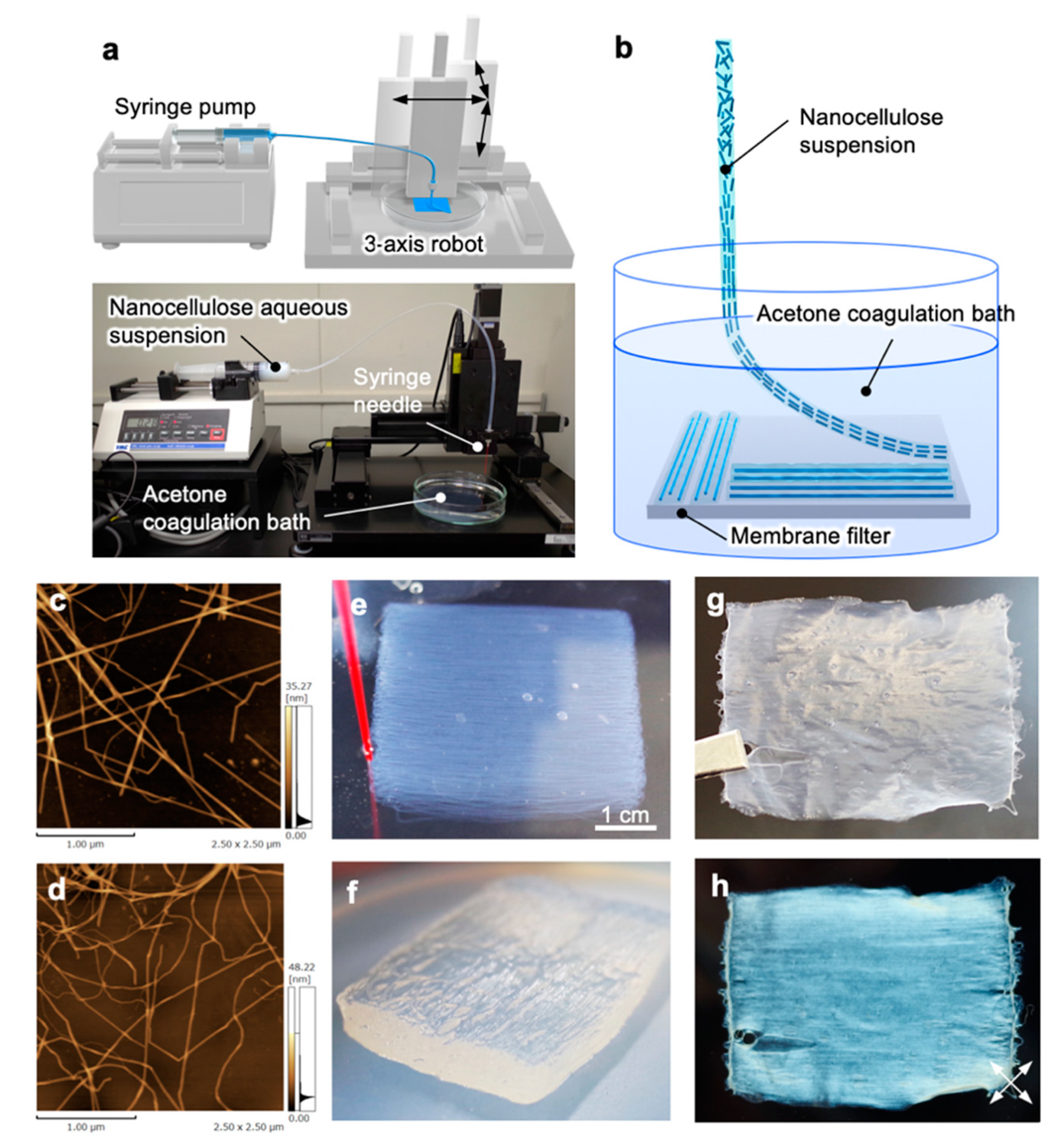
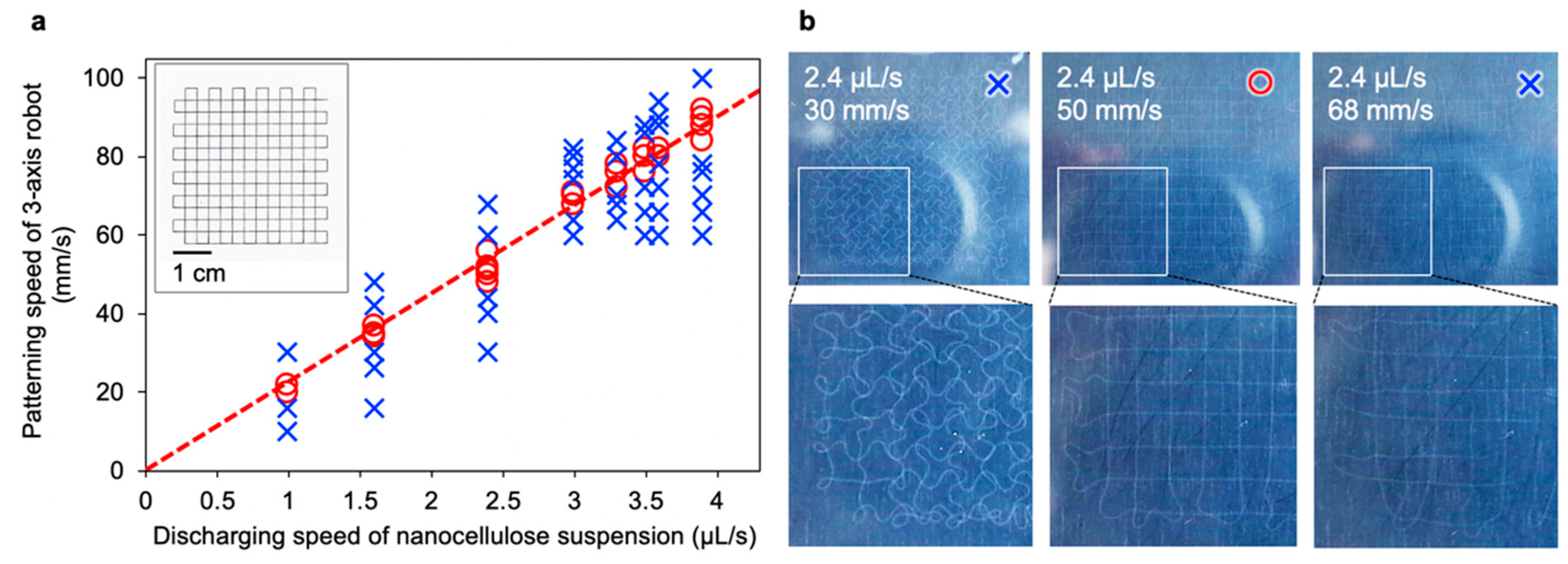
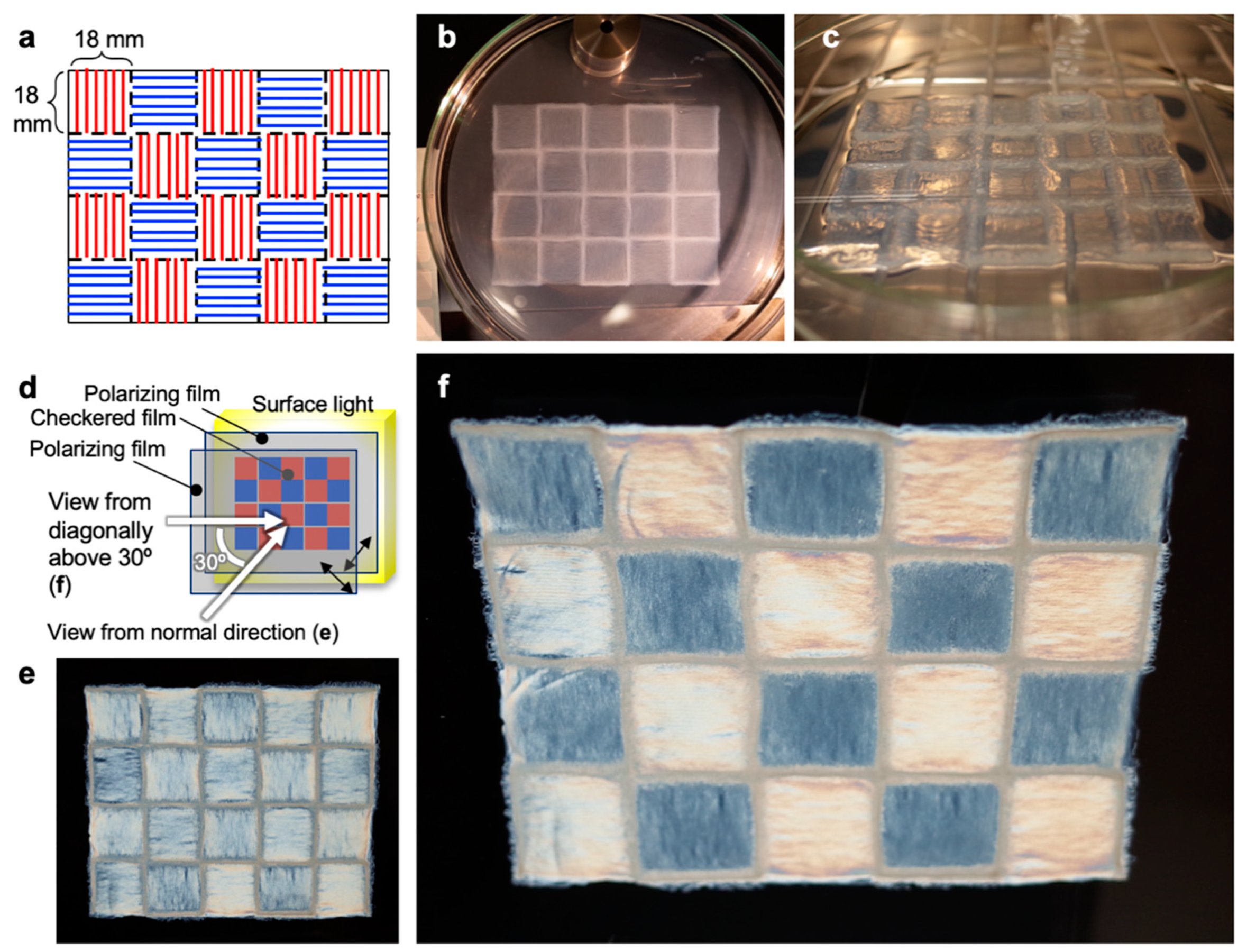
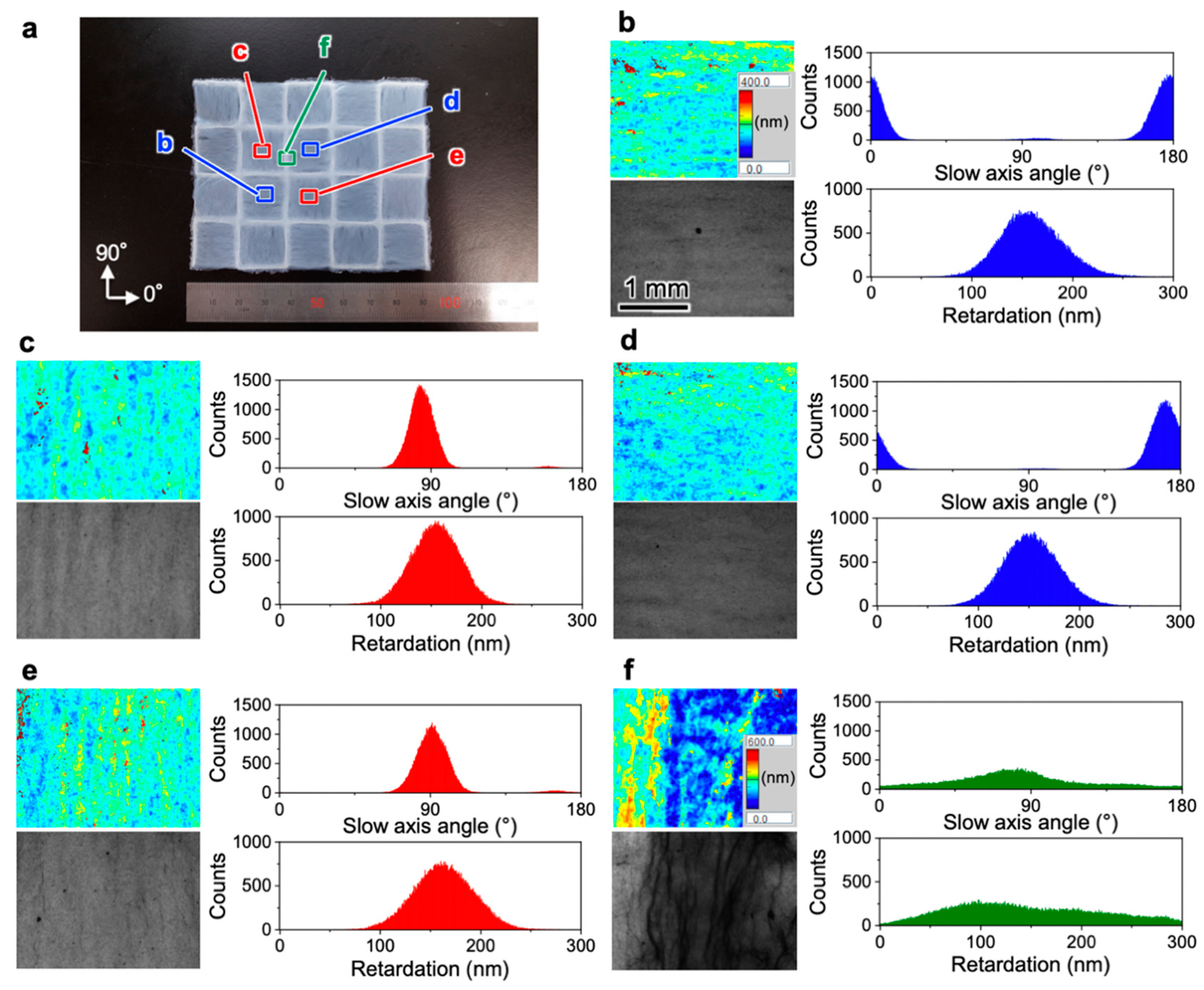
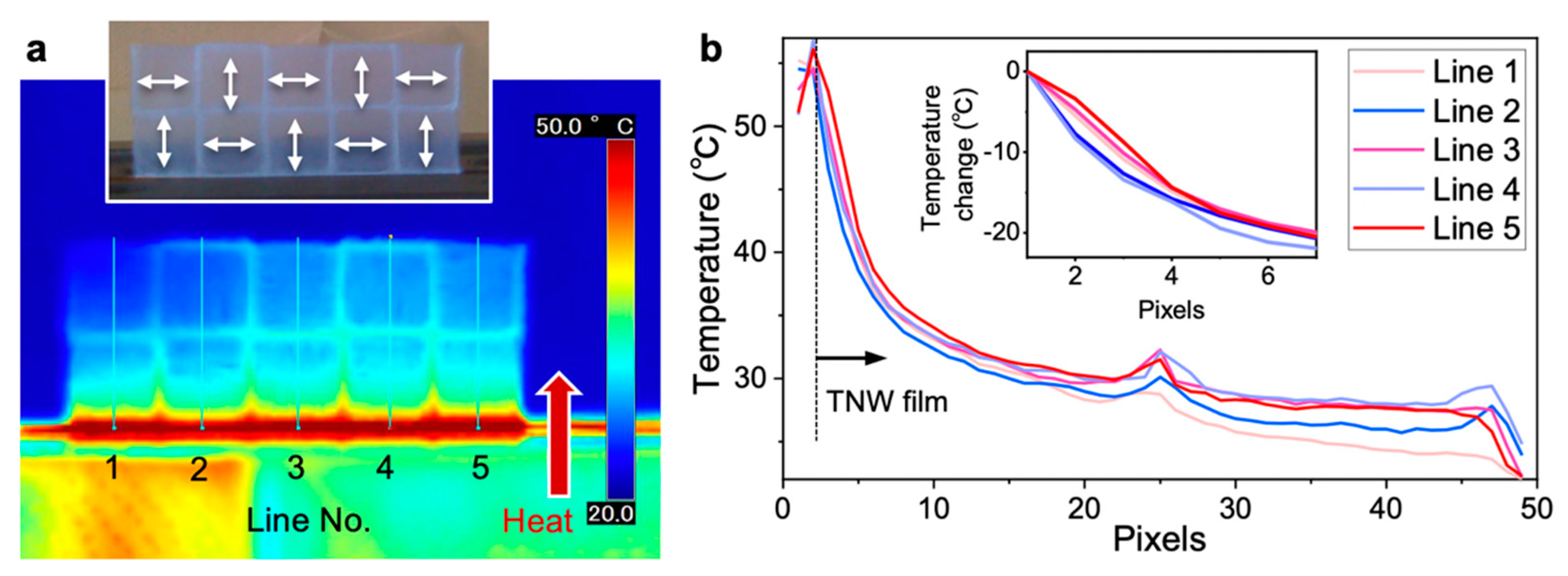
| Type of Nanocellulose and Name | Concentration of the Discharging Suspension (wt%) | Syringe Needle Diameter (mm) | Discharging Speed of the Suspension (µL/s) | Patterning Speed of the Three-Axis Robot (mm/s) | Oven Drying Temperature (°C) | Thickness of the Dried Film (µm) | Orientational Order Parameter S | |
|---|---|---|---|---|---|---|---|---|
| TNF | ~0.5 | 0.25 | 2.4 | 50 | 50 | 52 | 0.07 | |
| 3 | 71 | 38 | 0.08 | |||||
| 3.6 | 82 | 45 | 0.07 | |||||
| 3.9 | 90 | 36 | 0.07 | |||||
| 80 | 53 | 0.09 | ||||||
| TNW | W1 | 0.40 | 0.12 | 1 | 90 | 50 | 21 | 0.10 |
| W2 | 1.22 | 1 | 136 | 0.16 | ||||
| W3 | 1 | 53 | 0.10 | |||||
| W4 | 1 | 51 | 0.09 | |||||
| W5 | 0.17 | 2 | 64 | 0.11 | ||||
| W6 | 0.25 | 3.9 | 59 | 0.14 | ||||
| W7 | 0.91 | 0.12 | 1 | 52 | 0.13 | |||
© 2020 by the authors. Licensee MDPI, Basel, Switzerland. This article is an open access article distributed under the terms and conditions of the Creative Commons Attribution (CC BY) license (http://creativecommons.org/licenses/by/4.0/).
Share and Cite
Uetani, K.; Koga, H.; Nogi, M. Checkered Films of Multiaxis Oriented Nanocelluloses by Liquid-Phase Three-Dimensional Patterning. Nanomaterials 2020, 10, 958. https://doi.org/10.3390/nano10050958
Uetani K, Koga H, Nogi M. Checkered Films of Multiaxis Oriented Nanocelluloses by Liquid-Phase Three-Dimensional Patterning. Nanomaterials. 2020; 10(5):958. https://doi.org/10.3390/nano10050958
Chicago/Turabian StyleUetani, Kojiro, Hirotaka Koga, and Masaya Nogi. 2020. "Checkered Films of Multiaxis Oriented Nanocelluloses by Liquid-Phase Three-Dimensional Patterning" Nanomaterials 10, no. 5: 958. https://doi.org/10.3390/nano10050958
APA StyleUetani, K., Koga, H., & Nogi, M. (2020). Checkered Films of Multiaxis Oriented Nanocelluloses by Liquid-Phase Three-Dimensional Patterning. Nanomaterials, 10(5), 958. https://doi.org/10.3390/nano10050958







